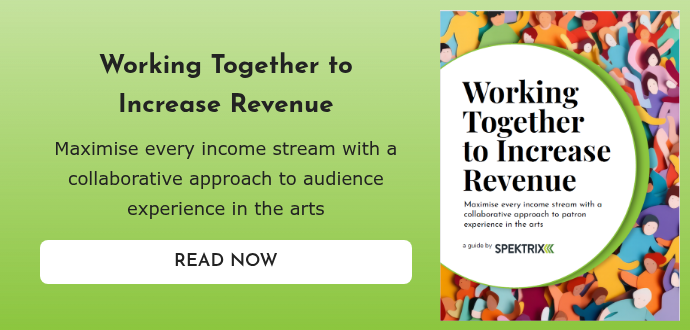3 min read
5 Theatre Marketing Strategies to Increase Revenue

Brush up your current campaigns or start a new campaign from scratch, with five arts marketing strategies that you can use to boost revenue.
There’s an art to stretching time and budgets, and arts marketers know it all too well. With constrained resources and countless items on their schedules, it can be challenging to find the time to brainstorm new strategies and leverage the tools to implement them.
We’ve worked with hundreds of arts marketing teams in theatres and music venues worldwide. From those conversations, we’ve gathered our top five ideas for boosting revenue as a theatre marketing team.
1. Upsell, cross-sell and ask
Transactions which contain additional items increase cart value by 35% on average
The most successful organisations see donations being added to more than 20% of all transactions
Take a close look at your ticket purchase pathway. Ideally, involve colleagues from your ticketing and fundraising teams and brainstorm where to upsell customers additional items they might purchase, cross-sell events they might be interested in, or ask them to support your artistic or community programme. Leverage data to check your hypotheses and continually review your initiatives over time.
- Use multi-buy offers to encourage audience members to add tickets to more shows, for a small percentage discount
- Include a one-click donation tool on your website to encourage online giving
- Add value to existing offerings and sell them at a higher pricing tier. This might mean packaging a ticket with a drink package or backstage tour. Many customers will opt for a premium experience when given the option, but no one will pay for it if it’s never offered to them.
2. Pre-sell concessions and merchandise
Creating a memorable evening doesn’t have to start and stop at the stage. Encourage customers to pre-order drinks or food online through your ticketing system.
Pre-selling concessions benefits audiences’ on-site experience and increases revenue for your theatre as well. These simple marketing strategies keep customers from having to wait in a busy queue, shortening the wait for other visitors to order on the day of the show and increasing the number of sales you can manage within a small time window. And there are benefits for your front of house team too, helping them forecast how much inventory to stock and streamlining audience movement around your venue.
Pre-selling doesn’t have to stop at catering. Think of creative ways to prompt customers to pre-order t-shirts, souvenirs, car parking, ticket insurance or other merchandise.
3. Set up add-on events
Introducing experiences that relate to the main event can be a great way to keep people in your building, adding value to their experience and increasing secondary spend. Consider post-show talks, meet and greets with artists, opening night receptions or any other event that can make for a memorable experience.
Unique opportunities like these are a great way to increase one-off ticket sales. Or if your focus is on building recurring revenue through your membership programme, donor pool or subscriptions, create money-can’t-buy opportunities to boost the value of loyalty. These don’t have to cost you the earth - audiences place huge value on the things you take for granted, from backstage tours to video chats with your Artistic Director.
4. Segment, segment, segment
Open rates on segmented emails outperform unsegmented emails by 56%
Click rates on segmented emails outperform unsegmented emails by over 100%
If you’re looking for an easy way to improve marketing to your patron base, create a customer segmentation model. Start by determining what data you have available to help you understand audience behaviors as ticket buyers, donors and supporters, then create individual marketing strategies for every segment. Consider everything from content, tone, frequency, price points and incentives to establish the right offer for each group of patrons.
Segmentation is the starting point for most of your successful revenue generation activity. If you’re a Spektrix user, get started with segmentation by watching our Spotlight Session: Supercharge your Segmentation.
5. Send automated emails
There are many email marketing tools available that can streamline key touchpoints with your audience members by scheduling automated emails. One of the simplest places to start is with pre- and post-event emails, which are a great way to share practical information, promote upcoming events, and capitalize on customers’ excitement.
Drip campaigns that trigger a series of timed or action-based emails are another great tool. Here are a few ideas for implementing drip campaigns:
Win back lapsed bookers
Reach out 12 months after their last visit, tell them you miss them, and offer them a small incentive to return - provided they book within two weeks. Follow up with short, targeted messaging about events that might interest them and reminders so they don’t miss out.
Add value to memberships
If members aren’t getting the full value from their payments, they’re less likely to renew. Email members who have used less than 50% of their benefits at the mid-point of your season, reminding them of all you have to offer and ensuring they know how to book.
Improve donor loyalty
A simple thank you after a first donation makes a huge difference. Follow up a few months later to demonstrate how that contribution has impacted your artistic programme or community activity, and invite an additional gift or recurring donation.
Email automation is a huge asset for busy marketers because once they’re up and running, they don’t require a lot of attention. Automated campaigns are versatile, reliable, and can help move audience members to their next step in their customer journey, whether they’re first-time attenders, repeat bookers or regular supporters of your arts organisation.
Get your marketing strategies underway
The revenue generation ideas listed here are just starting points. It’s up to you to find the most effective arts marketing campaigns, aligning your planning to your organisational goals and finding creative ways to make your efforts succeed. Together, these tools can round out existing strategies and increase your organisation’s revenue.
Firat Gülmez is an Apprentice Software Engineer at Spektrix



